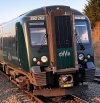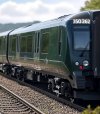I thought that too but as said before, I think they are better off as 158/159 replacements alongside with the 450's.
At the lower end of the seating capacity quoted on Wikipedia the 350's have 230 seats vs the 159's 169 seats, which would mean when comparing a 9 coach service with a 12 an uplift of 183 seats (not sure on the uplift vs a 10 coach 158/159 train, but it would likely be over 100 seats).
Even an 8 coach train formed of 350's would only reduce the seating capacity by 47 seats.
Given that there's also a total to 37 158/159's at SWR the numbers match, but without the need to use 158's to create capacity into Waterloo it would likely mean more pairs of services could run.
The Salisbury 6 services (which run Salisbury, Romsey through Southampton and back to Romsey before doing the reverse on the way back) would likely work well as battery trains due to the fairly short distances off the wires but with an electric charge in the middle of the run.
You'd need to roll out station batteries for top up charging on the way to Exeter, however as the trains often have to wait for the service coming the other way (and with better acceleration and a higher top speed) such station stops could be long enough for a bit of a top up without materially changing journey times.
For example both Salisbury and Yeovil each have a 5 minute timetable stop, which might be able to be lengthened to 6 or 7 minutes without altering the overall journey time. This compares well with the 3.5 minutes at West Ealing which the battery trains needed for the Greenford Branch services (yes I know it's a short branding, but then there's potential to double the length of charge time).
Andover has a 3 minute stop, as it's the stop in the Tisbury Loop (on the down), both would be useful top ups.
Further down your need to lengthen some other station stops to be sure, however Honiton and Axminster are already 2 minutes, so potential for a bit of a top up at each. Although there's also stops at Axminster West Junction and Pinhoe for pathing on the single track sections, which may also provide a bit more charge.
That's 8 locations with potential for charging.
You'd also need some charging in the depot at Exeter.
Ideally you'd want some electrification at Exeter (at least to Exmouth Junction, if not Pinhoe), which could help if the 80x's were to also look to be converted to be battery trains (although would reduce the need for diesel burn none the less). As it's currently single track a length of a (say) 20 miles of electrification along the route would also certainly help and might not be too complex (and because of the batteries many of the bridges may not need much doing even if the clearances were too tight for electrification) which could keep the costs low(ish).


